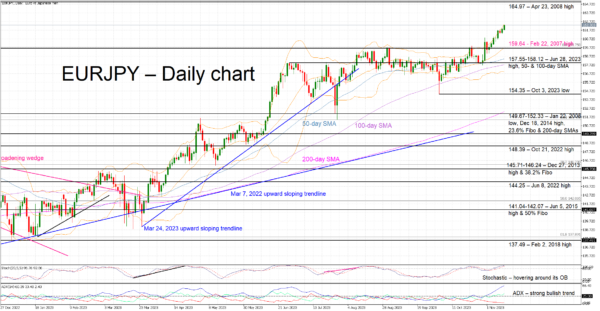- GDP report for Q3 will be released on Wednesday 01.50 GMT
- Market feeling disappointed after recent BoJ gathering
- Yen crosses record new highs, ignore intervention threat
Market did not enjoy the last BoJ meeting
The recent Bank of Japan meeting failed to live up to its expectations despite the fact that Governor Ueda made another small step towards the targeted normalization. The famous yield curve control mechanism was updated with the 1% hard cap being transformed into a reference cap where the BoJ aims to conduct nimble operations. In essence, the 10-year Japanese yield is now allowed to trade above this level, with the BoJ looking ready to intervene forcefully when the pace of adjustment looks too aggressive for its liking.
Interestingly, the Policy Board’s median forecasts for core CPI were also upgraded. The projection for the fiscal year of 2024 increased to 2.8% from 1.9% at the July projections, with the core CPI print for the fiscal year of 2025 seen at a modest 1.7%. The 2025 figure is the reason why the BoJ has not moved more aggressively in its normalization process. Governor Ueda and his crew are looking for stronger signs that domestic demand could support the recent elevated inflation rates. And they assume that this could only happen if monetary policy remains extra supportive and wages continue to rise significantly.
In this context, Japan’s UA Zensen Union, representing mostly manufacturing sector workers, has lodged a claim for a 6% wage hike for a second consecutive year, and one of Japan’s biggest banks has increased its deposit rates for the first time in 12 years. This is probably music to the ears of the BoJ but not yet enough for the central bank to announce its first rate hike since 2007. Governor Ueda is looking for concrete signs that higher wages and rising prices are becoming embedded in the public’s mindset, and not seen as a one-off event driven by external factors.
Importantly, recent economic data has been on the positive side with the PMI surveys surprising on the upside and labor cash earnings showing a yearly increase of 1.2% in September. This might not look like much when compared to other developed nations’ figures, but these data prints are close to what the BoJ has been hoping for.
Key data releases this week
This week the market will be updated on the preliminary GDP print for the third quarter of 2023, following a very strong second quarter. The initial GDP figures from both the US and the UK managed to surprise on the upside, thus raising the possibility for a stronger print than the -0.1% QoQ penciled in now by market analysts. Similarly, lots of focus will be on the GDP price index, which in the previous quarter surpassed the 2015 high of 3.4%.
Equally important will be Thursday’s trade balance data for the month of October. The BoJ would be interested in any signs of a pick-up in imports that have been crashing from the 2022 highs, partly due to the drop in oil and gas prices.
Euro-yen continues higher undaunted
The sky appears to be the limit for yen crosses. The recent disappointing BoJ meeting allowed the euro-yen bulls to stage another rally with the pair recording a new 2023 high and apparently setting course for the April 23, 2008 high at 164.97. The threat of intervention does not seem to trouble the euro bulls since Japanese authorities have up to now limited their reaction to just verbal intervention, possibly at the request of the BoJ.
Having said that, a positive set of figures, especially a stronger GDP print, could result in a bearish reaction with the bears potentially trying to reclaim the 159.64 level. However, this move will most likely prove short-lived. On the flip side, a plethora of weak data releases would satisfy the euro-yen bulls as they potentially continue to test the Japanese authorities’ patience.












